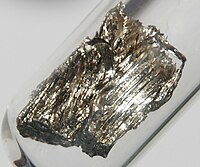
Photo from wikipedia
Abstract A precursor is prepared through complex sol–gel method using Sm3+ as activator, and Na+, Li+, and K+ as charge compensators. First, the luminescent property of SrMoO4:Sm3+ red phosphor is… Click to show full abstract
Abstract A precursor is prepared through complex sol–gel method using Sm3+ as activator, and Na+, Li+, and K+ as charge compensators. First, the luminescent property of SrMoO4:Sm3+ red phosphor is optimized by sintering at 700 °C, 800 °C, 900 °C, 1000 °C, and 1100 °C. Then, the influence of the charge compensators on the properties of SrMoO4:Sm3+ red phosphor is investigated. The phase, morphology, composition, luminescent property, quantum efficiency, and CIE coordinates of the phosphors are tested and characterized using an X-ray diffractometer, scanning electron microscope, photoelectron spectrometer, fluorescence spectrometer, FluoroMax-4 spectrometer, and Fourier transform infrared spectrometer. Analysis results indicate that the prepared SrMoO4:Sm3+ phosphor exhibits tetragonal structure, the calcination temperature and the type of charge compensators have little effect on host crystal structure, and the morphology of SrMoO4:Sm3+ phosphor is torispherical or ellipsoid. When SrMoO4:Sm3+ phosphor is excited by the 403 nm near-ultraviolet wavelength, the emission peaks are located at 563, 600, 646, and 707 nm respectively, which belong to the 4G5/2→6HJ (J = 5/2, 7/2, 9/2, 11/2) electron transition. The luminescent intensity of the main emission peak at 646 nm is the maximum. The variations of luminescence and luminescence decay with temperature are measured. Luminescent intensity, fluorescence lifetime and quantum efficiency reach their maximum values when the calcination temperature is 1000 °C. With the change of charge compensator type, the order of fluorescence intensity and quantum efficiency (from highest to lowest) is K+>Na+>Li+. The quantum efficiency and thermal stability of SrMoO4:Sm3+:K+ phosphor are the best, and the maximum quantum efficiency reaches 40.46%.
Journal Title: Journal of Luminescence
Year Published: 2019
Link to full text (if available)
Share on Social Media: Sign Up to like & get
recommendations!